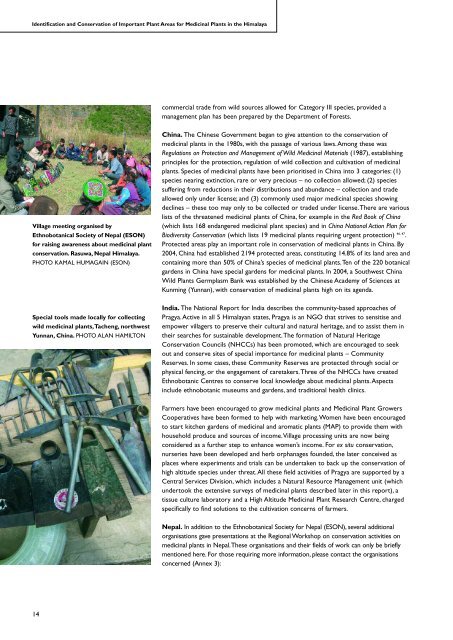Identification and Conservation of Important Plant Areas - Plantlife
Identification and Conservation of Important Plant Areas - Plantlife
Identification and Conservation of Important Plant Areas - Plantlife
- No tags were found...
Create successful ePaper yourself
Turn your PDF publications into a flip-book with our unique Google optimized e-Paper software.
<strong>Identification</strong> <strong>and</strong> <strong>Conservation</strong> <strong>of</strong> <strong>Important</strong> <strong>Plant</strong> <strong>Areas</strong> for Medicinal <strong>Plant</strong>s in the Himalayacommercial trade from wild sources allowed for Category III species, provided amanagement plan has been prepared by the Department <strong>of</strong> Forests.Village meeting organised byEthnobotanical Society <strong>of</strong> Nepal (ESON)for raising awareness about medicinal plantconservation. Rasuwa, Nepal Himalaya.PHOTO KAMAL HUMAGAIN (ESON)China. The Chinese Government began to give attention to the conservation <strong>of</strong>medicinal plants in the 1980s, with the passage <strong>of</strong> various laws.Among these wasRegulations on Protection <strong>and</strong> Management <strong>of</strong> Wild Medicinal Materials (1987), establishingprinciples for the protection, regulation <strong>of</strong> wild collection <strong>and</strong> cultivation <strong>of</strong> medicinalplants. Species <strong>of</strong> medicinal plants have been prioritised in China into 3 categories: (1)species nearing extinction, rare or very precious – no collection allowed; (2) speciessuffering from reductions in their distributions <strong>and</strong> abundance – collection <strong>and</strong> tradeallowed only under license; <strong>and</strong> (3) commonly used major medicinal species showingdeclines – these too may only to be collected or traded under license.There are variouslists <strong>of</strong> the threatened medicinal plants <strong>of</strong> China, for example in the Red Book <strong>of</strong> China(which lists 168 endangered medicinal plant species) <strong>and</strong> in China National Action Plan forBiodiversity <strong>Conservation</strong> (which lists 19 medicinal plants requiring urgent protection) 46, 47 .Protected areas play an important role in conservation <strong>of</strong> medicinal plants in China. By2004, China had established 2194 protected areas, constituting 14.8% <strong>of</strong> its l<strong>and</strong> area <strong>and</strong>containing more than 50% <strong>of</strong> China’s species <strong>of</strong> medicinal plants.Ten <strong>of</strong> the 220 botanicalgardens in China have special gardens for medicinal plants. In 2004, a Southwest ChinaWild <strong>Plant</strong>s Germplasm Bank was established by the Chinese Academy <strong>of</strong> Sciences atKunming (Yunnan), with conservation <strong>of</strong> medicinal plants high on its agenda.Special tools made locally for collectingwild medicinal plants,Tacheng, northwestYunnan, China. PHOTO ALAN HAMILTONIndia. The National Report for India describes the community-based approaches <strong>of</strong>Pragya.Active in all 5 Himalayan states, Pragya is an NGO that strives to sensitise <strong>and</strong>empower villagers to preserve their cultural <strong>and</strong> natural heritage, <strong>and</strong> to assist them intheir searches for sustainable development.The formation <strong>of</strong> Natural Heritage<strong>Conservation</strong> Councils (NHCCs) has been promoted, which are encouraged to seekout <strong>and</strong> conserve sites <strong>of</strong> special importance for medicinal plants – CommunityReserves. In some cases, these Community Reserves are protected through social orphysical fencing, or the engagement <strong>of</strong> caretakers.Three <strong>of</strong> the NHCCs have createdEthnobotanic Centres to conserve local knowledge about medicinal plants.Aspectsinclude ethnobotanic museums <strong>and</strong> gardens, <strong>and</strong> traditional health clinics.Farmers have been encouraged to grow medicinal plants <strong>and</strong> Medicinal <strong>Plant</strong> GrowersCooperatives have been formed to help with marketing.Women have been encouragedto start kitchen gardens <strong>of</strong> medicinal <strong>and</strong> aromatic plants (MAP) to provide them withhousehold produce <strong>and</strong> sources <strong>of</strong> income.Village processing units are now beingconsidered as a further step to enhance women’s income. For ex situ conservation,nurseries have been developed <strong>and</strong> herb orphanages founded, the later conceived asplaces where experiments <strong>and</strong> trials can be undertaken to back up the conservation <strong>of</strong>high altitude species under threat.All these field activities <strong>of</strong> Pragya are supported by aCentral Services Division, which includes a Natural Resource Management unit (whichundertook the extensive surveys <strong>of</strong> medicinal plants described later in this report), atissue culture laboratory <strong>and</strong> a High Altitude Medicinal <strong>Plant</strong> Research Centre, chargedspecifically to find solutions to the cultivation concerns <strong>of</strong> farmers.Nepal. In addition to the Ethnobotanical Society for Nepal (ESON), several additionalorganisations gave presentations at the Regional Workshop on conservation activities onmedicinal plants in Nepal.These organisations <strong>and</strong> their fields <strong>of</strong> work can only be brieflymentioned here. For those requiring more information, please contact the organisationsconcerned (Annex 3):14
















